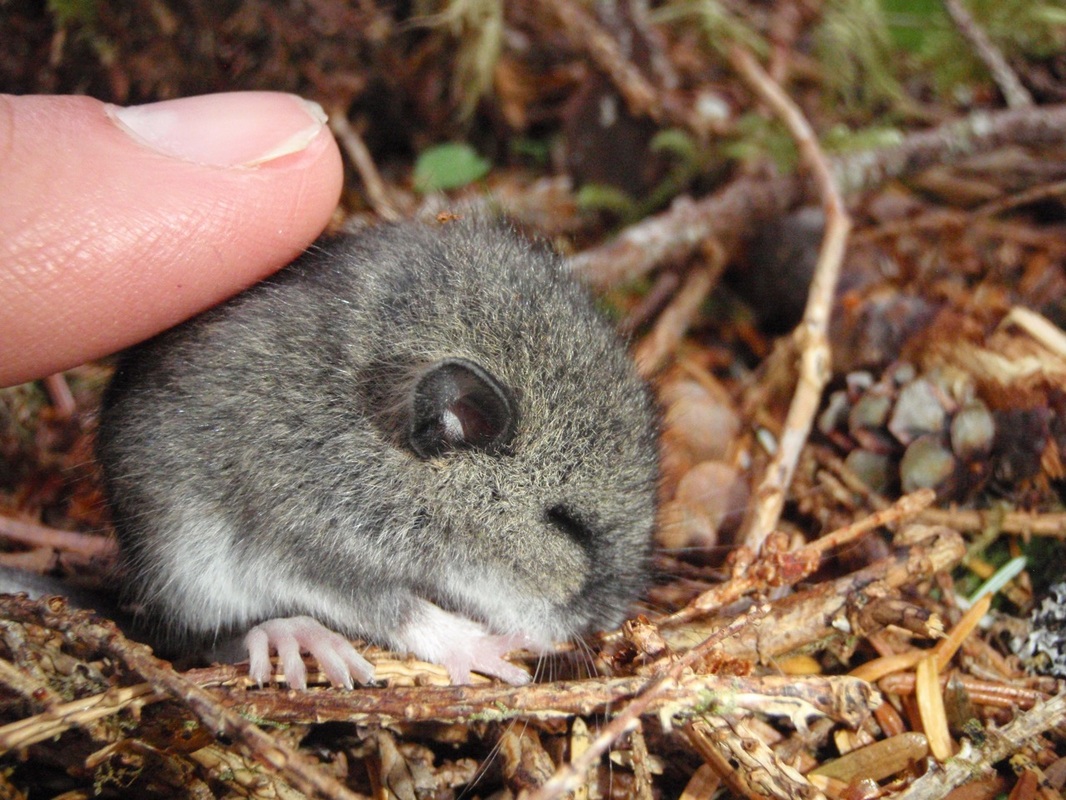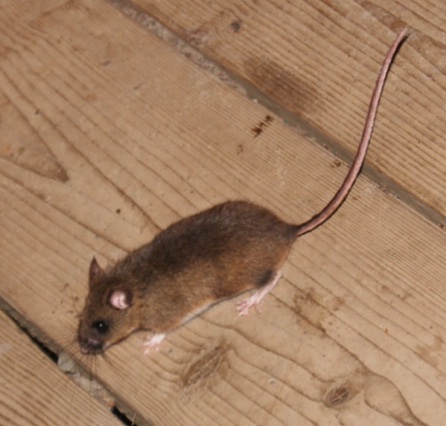Keen's mouse, Northwestern deer mouse, white-footed mouse • Peromyscus keeni

This juvenile Keen's mouse was sitting perfectly still on the forest floor when spotted and photographed by Chris Darimont.
|
Identification
This mouse has prominent whiskers and a long fur-covered tail. It tends to have light grey to white undersides and a darker back that varies from brown to grey or nearly black. There is significant colour variation between subspecies. One subspecies, found in the Hunter Island group of the Central Coast, has reddish-brown markings on its underside. The feet also vary in colour, from white to dark brown. There is also some variation in size, from 140-263 mm in length including the tail. The average length is approximately 20 cm; the tail and body are approximately the same length (the tail measures 10 cm on average). See page 139 of Nagorsen (2002) for more identification details. |
Habitat & Range
Keen's mouse is found in a variety of habitats along the coast of BC, though it prefers forested areas with somewhat open canopies. Its range stretches from the southwestern tip of Alaska/northwestern BC to the coast of Washington, and as far inland as the eastern coast of the Cascade and Coast mountain ranges. It is found on most coastal islands along this range, including Haida Gwaii and Vancouver Island. See a range map here.
Similar Species
The deer mouse (Peromyscus maniculatus) is nearly indistinguishable from Keen's mouse when in the field; however their ranges only overlap on Vancouver Island, some smaller nearby islands, and along the eastern slopes of the Cascade and Coast mountains. On average adult Keen's mouse tail lengths and cranial measurements are larger than those of adult deer mice, but the ranges of these measurements do overlap. The only reliable distinguishing factors are genetic testing or skull measurements that can't be performed on live mice. See pages 139-140 of Nagorsen (2002) for more information.
Intriguing Info
This mouse is a skilled climber and jumper.
A predation study of mice and seabirds on Triangle Island suggests seabird eggs are an important source of protein for coastal Keen's mouse populations, and the presence of seabird colonies may influence population levels of mice on BC coast islands.
iNaturalist
https://www.inaturalist.org/taxa/44387-Peromyscus-keeni
Keen's mouse is found in a variety of habitats along the coast of BC, though it prefers forested areas with somewhat open canopies. Its range stretches from the southwestern tip of Alaska/northwestern BC to the coast of Washington, and as far inland as the eastern coast of the Cascade and Coast mountain ranges. It is found on most coastal islands along this range, including Haida Gwaii and Vancouver Island. See a range map here.
Similar Species
The deer mouse (Peromyscus maniculatus) is nearly indistinguishable from Keen's mouse when in the field; however their ranges only overlap on Vancouver Island, some smaller nearby islands, and along the eastern slopes of the Cascade and Coast mountains. On average adult Keen's mouse tail lengths and cranial measurements are larger than those of adult deer mice, but the ranges of these measurements do overlap. The only reliable distinguishing factors are genetic testing or skull measurements that can't be performed on live mice. See pages 139-140 of Nagorsen (2002) for more information.
Intriguing Info
This mouse is a skilled climber and jumper.
A predation study of mice and seabirds on Triangle Island suggests seabird eggs are an important source of protein for coastal Keen's mouse populations, and the presence of seabird colonies may influence population levels of mice on BC coast islands.
iNaturalist
https://www.inaturalist.org/taxa/44387-Peromyscus-keeni
References
Drever, M.C., Blight, L.K., Hobson, K.A., and Bertram, D.F. (2000). Predation on seabird eggs by Keen's mice (Peromyscus keeni): using stable isotopes to decipher the diet of a terrestrial omnivore on a remote offshore island. Can. J. Zool. 78: 2010-2018.
Nagorsen, D.W. (2002). An Identification Manual to the Small Mammals of British Columbia. British Columbia Ministry of Sustainable Resource Management, Ministry of Water, Land, and Air Protection, Biodiversity Branch, and Royal BC Museum. Pp. 139-140.
Peromyscus keeni Northwestern Deermouse. North American Mammals. Smithsonian National Museum of Natural History. Accessed 13/03/2014.
Authors and editors of page
Kelly Fretwell and Brian Starzomski (2014).
Drever, M.C., Blight, L.K., Hobson, K.A., and Bertram, D.F. (2000). Predation on seabird eggs by Keen's mice (Peromyscus keeni): using stable isotopes to decipher the diet of a terrestrial omnivore on a remote offshore island. Can. J. Zool. 78: 2010-2018.
Nagorsen, D.W. (2002). An Identification Manual to the Small Mammals of British Columbia. British Columbia Ministry of Sustainable Resource Management, Ministry of Water, Land, and Air Protection, Biodiversity Branch, and Royal BC Museum. Pp. 139-140.
Peromyscus keeni Northwestern Deermouse. North American Mammals. Smithsonian National Museum of Natural History. Accessed 13/03/2014.
Authors and editors of page
Kelly Fretwell and Brian Starzomski (2014).





